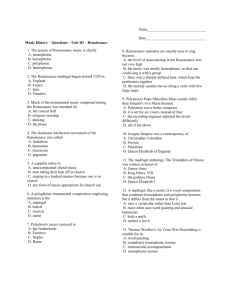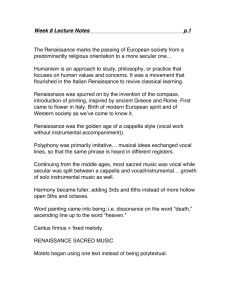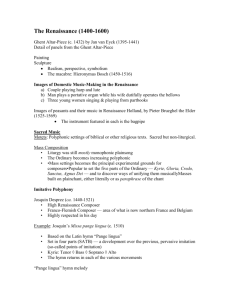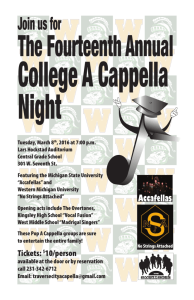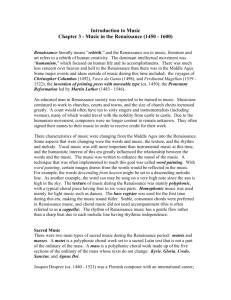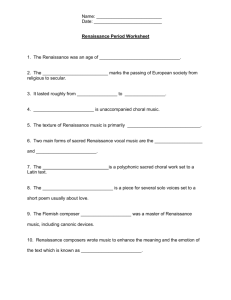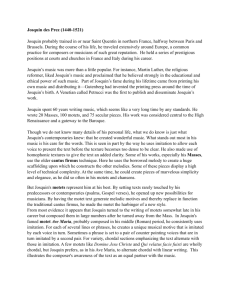Renaissance Declarative Knowledge
advertisement
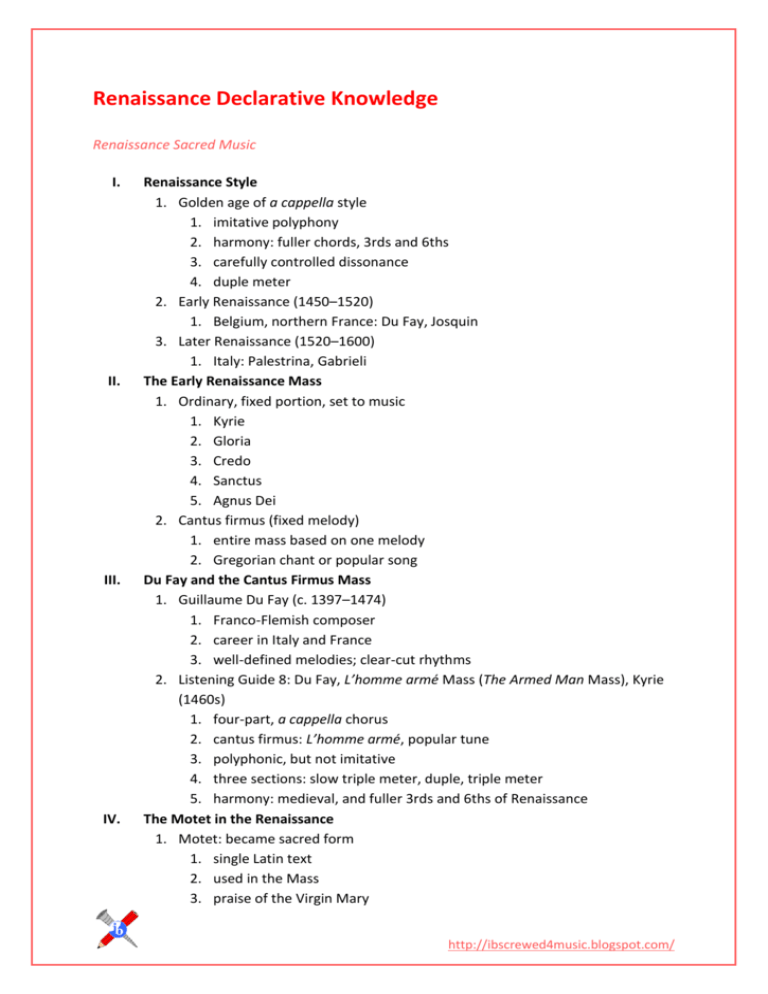
Renaissance Declarative Knowledge Renaissance Sacred Music I. II. III. IV. Renaissance Style 1. Golden age of a cappella style 1. imitative polyphony 2. harmony: fuller chords, 3rds and 6ths 3. carefully controlled dissonance 4. duple meter 2. Early Renaissance (1450–1520) 1. Belgium, northern France: Du Fay, Josquin 3. Later Renaissance (1520–1600) 1. Italy: Palestrina, Gabrieli The Early Renaissance Mass 1. Ordinary, fixed portion, set to music 1. Kyrie 2. Gloria 3. Credo 4. Sanctus 5. Agnus Dei 2. Cantus firmus (fixed melody) 1. entire mass based on one melody 2. Gregorian chant or popular song Du Fay and the Cantus Firmus Mass 1. Guillaume Du Fay (c. 1397–1474) 1. Franco-Flemish composer 2. career in Italy and France 3. well-defined melodies; clear-cut rhythms 2. Listening Guide 8: Du Fay, L’homme armé Mass (The Armed Man Mass), Kyrie (1460s) 1. four-part, a cappella chorus 2. cantus firmus: L’homme armé, popular tune 3. polyphonic, but not imitative 4. three sections: slow triple meter, duple, triple meter 5. harmony: medieval, and fuller 3rds and 6ths of Renaissance The Motet in the Renaissance 1. Motet: became sacred form 1. single Latin text 2. used in the Mass 3. praise of the Virgin Mary http://ibscrewed4music.blogspot.com/ V. VI. VII. 4. three, four, or more voices of equal importance 5. cantus firmus: chant or popular song Josquin des Prez and the Motet 1. Josquin des Prez (c. 1450–1521) 1. northern French composer 2. Italian court positions; papal choir in Rome 3. humanism: expressive harmony, serene melodies 4. sacred and secular compositions 2. Listening Guide 9: Josquin, Ave Maria . . . virgo serena (Hail Mary . . . gentle virgin) (1480s) 1. Latin motet 2. four-voice, a cappella choir 3. varied combinations of voices and textures The Reformation and Counter-Reformation 1. Reformation: Protestant Revolt 1. Martin Luther (1483–1546): Ninety-Five Theses, 1517 1. Augustinian monk 2. excommunicated by Catholic church 2. mass in vernacular 3. hymns sung communally 2. Counter-Reformation: Catholic church response 1. recapture loyalty of people: accessible music 2. Council of Trent (1545–1563) concerns 1. embellishments to Gregorian chant 2. objected to certain instruments in church 3. use of popular songs in Masses 4. secular spirit in sacred music 5. irreverent attitude of church musicians 6. complex polyphony obscured the text 3. Council favored pure vocal style 1. simplicity, clarity 2. respected integrity of sacred texts 3. encourage piety Palestrina and the Pope Marcellus Mass 1. Giovanni Pierluigi da Palestrina (c. 1525–1594) 1. Italian composer, organist, choirmaster 2. worked at St. Peter’s in Rome and Sistine Chapel Choir 3. mostly sacred compositions; over 100 Masses 4. pure, a cappella, vocal polyphony 2. Listening Guide 10: Palestrina, Pope Marcellus Mass, Gloria (1567) 1. six-part, a cappella male choir http://ibscrewed4music.blogspot.com/ 2. 3. 4. 5. monophonic opening homorhythmic and polyphonic textures follow clear declamation of the text full, consonant harmony PIECES: Josquin, Ave Maria… virgo serena Palestrina, Pape Marcellus Mass Renaissance Secular Music I. II. III. Music in Court and City Life 1. Professional musicians: court and civic festivities 2. Merchant class: music-making in the home 3. Women in music 1. music education: well-bred women 2. women achieved fame as professional singers 4. Important genres: chanson and madrigals The Chanson 1. Favored genre at Burgundian courts throughout 16th century 1. three or four voices 2. courtly love 3. freer poetic structures 4. preeminent composers: Du Fay, Josquin 2. Listening Guide 11: Josquin, Mille regretz (A thousand regrets) (1520) 1. four-voice, a cappella French chanson 2. through-composed, four-line love poem 3. homorhythmic and polyphonic textures 4. modal harmony: expresses sadness 5. syllabic, with melisma on “regretz” The Italian Madrigal 1. Secular vocal composition for three to eight voices 1. flourished at Italian courts 2. short poems: lyric or reflective character 3. music enhanced poetry 4. word painting: music depicts emotional words 1. weeping, sighing, trembling, etc. 5. instruments double or substitute voices 2. Early madrigal (c. 1525–50) 3. Later madrigal (1580–1620) 1. extends into Baroque era http://ibscrewed4music.blogspot.com/ IV. V. 2. rich chromatic harmony, vocal virtuosity 3. Claudio Monteverdi: transitional composer 4. Jacques Arcadelt (c. 1507–1568) 1. Franco-Flemish composer; early madrigalist 2. worked in Italy and France 3. secular compositions: chansons, madrigals 4. sacred compositions: Masses, motets 5. simpler, lyrical style 5. Listening Guide 12: Arcadelt, Il bianco e dolce cigno (The white and sweet swan) (1538) 1. four-voice, a cappella madrigal 2. through-composed 10-line poem 3. lyrical, conjunct melody 4. mostly homophonic, consonant, full harmony 5. emotional words: dissonance, chromaticism, melisma, repetition The English Madrigal 1. Flourished during Elizabethan era (1558–1603) 1. “Englished” Italian madrigals 2. less serious, lighter texts 3. composers: Thomas Morley (1557–1603), Thomas Weelkes (c. 1575– 1623), John Farmer 2. John Farmer (c. 1570–1603) 1. English composer, organist 2. composed only one madrigal collection 3. light-hearted style, clever word painting 3. Listening Guide 13: Farmer, Fair Phyllis (1599) 1. four-voice, a cappella English madrigal 2. dancelike, lively rhythms 3. varied textures 4. word painting: “all alone,” and “up and down” Instrumental Dance Music 1. 16th century: purely instrumental music developed 1. printing: published music readily available 2. books of dances for solo instruments or small ensembles 3. instrumentation not specified: determined by occasion 4. percussion parts not notated: improvised 5. dance types: pavane, saltarello, galliard, allemande, ronde 2. Tielman Susato (c. 1515–1571) 1. Flemish composer, instrumentalist, printer 2. Danserye: popular instrumental dance collection (1551) 3. Listening Guide 14: Susato, Three Dances (1551) http://ibscrewed4music.blogspot.com/ 1. 2. 3. 4. 5. 6. VI. three rondes, each in binary form (A-A-B-B) repeated sections: improvised embellishments dances flow from one to the next duple meter, homophonic texture consonant harmony; Ronde 2, modal performed by loud wind band 1. shawm, sackbut, cornetto, tabor, tambourine 4. From the Renaissance to the Baroque 1. humanistic spirit 2. sought expressive means 3. shift to single-line music Giovanni Gabrieli and Instrumental Music in Venice 1. Venice: important musical center by end of 16th century 1. major seaport; at crossroads of trade with the East 2. Venetian style 1. multiple choirs of voices and instruments 2. antiphonal: groups play in alternation 3. influenced composers all over Europe 3. Giovanni Gabrieli (c. 1557–1612) 1. composer and organist 2. worked at St. Mark’s in Venice 3. sacred and secular compositions 4. instrumental ensemble music; polychoral works 5. first to indicate dynamics; specify specific instruments 4. Listening Guide 15: Gabrieli, Canzona septimi toni (1597) 1. instrumental canzona: sectional work 2. two instrumental groups: antiphonal style 3. shifting meters: duple and triple 4. mostly homophonic PIECES: Arcadelt, Il Bianco e dolce cigno Farmer, Fair Phyllis Susato, Three Dances http://ibscrewed4music.blogspot.com/ Comparison between Renaissance and Baroque Melody Rhythm Renaissance Simple melodies Mostly stepwise Consistent rhythms Slow underlying pulse Consistent tempos Often based on text Harmony Triadic, based on modes Dissonance on weak beats Sounds Equal voices Like instruments (consorts) Voices or instruments alone Instrumentation up to performer Single dynamic level Texture Imitative or homophonic Form Based on text or dance forms Baroque Ornate melodies Dramatic leaps common Wider variety of rhythms Faster, more regular pulse Varied tempos between movements Often based on dance rhytms Triadic, based on major/minor tonality Dissonance a fundamental part of chords Basso continuo accompaniment Wide variety of instrumental colors Free mix of voices and instruments Instrumentation defined by composer Dynamic contrasts (terraced) Melody and accompaniment New and abstract forms (binary and ternary) based on repetition The Renaissance: (1450 - 1600) o The Era: Rebirth of learning and culture, expressly the ideas of ancient Greece and Rome. Age of exploration and discovery: Christopher Columbus, Vasco da Gama, Ferdinand Magellan. Advances in science and astronomy. Copernicus. Gunpowder, the printing press. scientific inquiry. Humanism. Leonardo Da Vinci. the Renaissance man: scholar, painter, sculptor, inventor, scientist, musician. Visual art: perspective, realistic portrayal of the human figure, portraits, nude sculpture. Botticelli (Birth of Venus 1480) [PMG MAA p 108] Donatello (David 1400’s) [EOM p 84] Michalangelo (David 1504) [MAA p109] Da Vinci (Madonna and St. Anne 1500’s) - compare with Medieval madonna. [MAA plates] http://ibscrewed4music.blogspot.com/ It’s a veritable who’s who: Lorenzo de Medici (Machiavelli), Lucrecia Borgia, Erasmus, Luther, Galileo, Cervantes, Marlowe, Shakespeare. Gutenberg, Petrucci. Style: Form imitation, homorhythm, cantus firmus, text-dominated forms Melody relatively conjunct, contrapuntal lines, word painting Tone Color families or consorts of instruments, blend Harmony interval of the third; firmly regulated treatment of dissonance Rhythm smooth regular flow, or restless. Dance music strongly metrical, but in general complex interlocking phrases without emphasis on meter. Syncopation. Genres: mass - settings of the mass ordinary; this is where composers showed off their virtousity. [Palestrina: Pope Marcellus Mass, Credo NRAWM CD 1#14-18/ PMG NAWM vol 1 p 200/listening guide in PMG MFOT p 155] motet - polyphonic vocal work set to a sacred Latin text. More opportunity for experimentation in expressing different texts.[Josquin: Tu solus, qui facis mirabilia NRAWM CD2 # 23-26 / PMG NAWM p 111] chanson - Fr. for song. Our meaning here: French secular polyphonic song of the 14 - 16 centuries. [ Claude Le Jeune (c1600): Revecy venir du printans NRAWM CD2#61-69/no score] madrigal - secular polyphonic vocal work for 4 to 6 voices; imitative sections contrast with chordal ones; intimately tied to the text, with word painting evident; avoids fixed form. Sung at upper middle class social gatherings. Began in Italy and moved to England.[Italian: Willaert, Aspro core e selvaggio e cruda voglia, NRAWM CD2#42-46/PMG NAWM vol 1 p 242] [English: Farmer, Fair Phyllis PMG Quink English Madridgals#12/NS vol 1 p75] Instruments: crumhorn - capped double reed instrument with soft but very reedy tone. cornett - instrument made of wood or ivory, with a cup shaped mouthpiece. lute - fretted, plucked string instrument with bent neck; strings tuned in pairs. sackbut - a mellow, softer precursor of the modern trombone. rackett - low pitched double reed instrument; coiled lengthy tube in a small box. recorder - wooden, just like the plastic one you played in grade school. shawm - harsh loud precursor of the oboe. viol - bowed stringed instrument with a fretted neck; six strings tuned a fourth apart w/a major third in the middle. (A d g b e’ a’). Held upright in front of player. Vocabulary ayre - air, or song - a type of English madrigal. Often printed in three directions so performers could sit around a table. http://ibscrewed4music.blogspot.com/ a cappella - the ideal of Renaissance vocal music. Unaccompanied. academy - a “learned society” for the purpose of furthering the arts, literature, or science. ballett - like a madrigal but dance-like, strophic, homophonic and with falala refrain. cantus firmus (Medieval) - chant or chant fragment on which polyphony is based. consort - different pitched family of like instruments. chorale - Protestant hymn; tunes frequently used as cantus firmi. canzona - instrumental counterpart of the chanson. cori spezzati - divided choirs; often associated with the widely seperated choir lofts of St. Marks in Venice. Gabrieli was the master of the polychoral motet. fauxbourdon - Dufay compositional technique for 3 voices using the interval of a 6th; creating basically 1st inversion triads. frottola - Italian secular precersor of the Madrigal. Lighter. lied - here, German polyphonic song of the late Middle Ages and Renaissance. pedal point - sustained note in the bass, over which harmonies move. pavane - galliard - commonly paired Renaissance dance set. Pavane = slow duple/galliard = fast triple ricercar - basically an instrumental motet. word painting (or tone painting) - intimate link between text and music, sometimes subtle, sometimes obvious. “As Vesta Was Descending” forms a descending line melodically. http://ibscrewed4music.blogspot.com/
